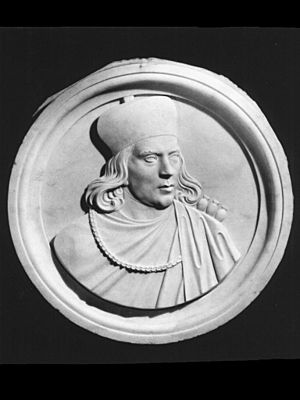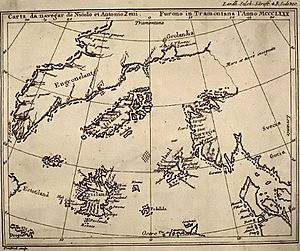Voyage of the Zeno brothers facts for kids
The Zeno brothers, Nicolò (born around 1326, died around 1402) and Antonio (died around 1403), were noblemen from Venice, Italy. They lived in the 1300s. They became famous in 1558 when their relative, Nicolò Zeno the Younger, published a map and some letters. These papers supposedly described a trip the brothers took to the North Atlantic and Arctic seas in the 1390s. The younger Nicolò said he found these old documents in a storage room in his family's house.
Many people believed the map when it was first published. Important mapmakers, like Gerardus Mercator, even included it in their own works. However, today, most historians and geographers do not believe the map or the stories of the voyages. Some even think the younger Zeno made them up.
Nicolò and Antonio were brothers of Carlo Zeno, a famous Venetian naval hero. The Zeno family was a well-known noble family in Venice. They even had the right to arrange travel between Venice and the Holy Land during the Crusades. According to the younger Zeno, the map and letters are from around 1400. They tell about a long journey the Zeno brothers made in the 1390s. They traveled with a prince named Zichmni. Some people think "Zichmni" might be a mistake for "d’Orkney," referring to a Scottish nobleman named Henry Sinclair, Earl of Orkney. The trip supposedly crossed the North Atlantic Ocean. Some believe they even reached North America almost 100 years before Christopher Columbus.
Contents
The Zeno Brothers' Amazing Journey
Nicolò and Antonio are known because of the letters and a map (called the "Zeno map"). These were published in 1558 by one of their family members, also named Nicolò Zeno. This later Nicolò was a historian who wrote other books about Venice's history. The letters, supposedly written by the brothers around 1400, describe an exploration trip. They claimed to have traveled across the North Atlantic. Some people even think they reached North America. They said they were led by a prince named Zichmni. Some believe Zichmni was actually Henry Sinclair.
Some people once thought that William Sinclair (who built Rosslyn Chapel) knew about Henry Sinclair's connection to the Zeno brothers. They suggested that carvings inside the chapel showed plants found on the trip. However, this idea has been proven wrong.
The letters and the map are very controversial. At least one historian believes they are a hoax. This means they were made up. It's thought either the Zeno brothers themselves made them up, or their descendant did. The descendant said he based his story on what was left of letters he had torn up as a boy. In 1989, an Italian expert named Giorgio Padoan studied the travels. He suggested that some parts of their journeys might be real. He noted that Nicolò is not mentioned in any documents between 1396 and 1400. This means he could have been in Iceland during that time.
What the Letters Said
The letters are split into two parts. The first part contains letters from Nicolò to Antonio. The second part has letters from Antonio to their brother Carlo.
The first letters (from Nicolò to Antonio) say that Nicolò started a trip in 1380. He sailed from Venice to England and Flanders. There is proof that Nicolò did make such a trip. He returned to Venice around 1385.
In the letters, Nicolò says he got stuck on an island called Frisland. This island was between Great Britain and Iceland. It was described as being larger than Ireland. By chance, Nicolò was rescued by Zichmni. Zichmni was a prince who owned some islands called Porlanda, off the southern coast of Frislanda. He also ruled a place called Sorant, southeast of Frislanda. Some people think Frislanda might actually be the Faroe Islands. They believe Nicolò the younger might have mistakenly combined several islands into one large landmass. However, Frisland and the Faroe Islands appear separately on many old maps, hundreds of miles apart.
Nicolò invited Antonio to come to Frislanda, and Antonio did. He stayed there for fourteen years. Under Zichmni's command, Antonio attacked "Estlanda." This is thought to be the Shetland Islands, because some place names mentioned in the letters are similar. Zichmni then tried to attack Iceland. But it was too well-defended. So, he attacked seven islands along its eastern side: Bres, Talas, Broas, Iscant, Trans, Mimant, and Damberc. All of these islands are made up.
Another idea is that when the Zeno brothers' descendant copied the letters, he confused "Estlanda" with "Islanda" (Iceland). This would explain why there are extra islands off Iceland and why the same number of islands are missing from the Shetland Islands. More proof for this idea is that names in the Zenos' "Islanda" are similar to names in modern-day Shetland. For example, the island of Bressay is like "Bres," and Danaberg sound near Lerwick is like "Damberc."
Zichmni then built a fort on Bres and left Nicolò in charge. Nicolò took a trip to Greenland and found a monastery with central heating. If the travelers were still in Estlanda (Shetland), as the alternative idea suggests, then their next stop would be Iceland. This would explain the hot springs and other things they saw.
Zichmni heard that a group of lost fishermen from Frislanda had returned after more than twenty-five years. The fishermen said they landed in unknown lands far to the west, called Estotiland and Drogeo. They claimed to have met strange animals and even cannibals. They escaped only after teaching the cannibals how to fish. Inspired by these stories, Zichmni began a trip to the west. Antonio was in charge of his ships. West of Frislanda (as shown on the Zeno map), they found a large island called Icaria, which does not exist.
According to the letters, the people of Icaria greeted them before they could land. Only one person among the Icarians could speak a language Zichmni understood. The people said that visitors were not welcome on the island. They said they would fight to the last person if needed. Zichmni sailed along the island looking for a place to land, but the people chased him. Zichmni gave up.
Sailing west, they landed at a point called Trin on the southern tip of "Engrouelanda." Zichmni liked the weather and the soil, but his crew found it difficult. The sailors went home with Antonio, while Zichmni stayed to explore the area and build a town.
The Mysterious Zeno Map
The Zeno map shows many islands that are now known as "phantom islands." These are islands that appeared on old maps but do not actually exist.
Phantom Islands on the Map
Estotiland: A Land of Mystery
"Estotiland" appears on the Zeno map on the western side of the Atlantic Ocean. It is roughly where Labrador is today, on the northeast coast of North America. Estotiland has been listed in books as a place like "utopia" or "paradise." It also inspired the Russian "Estoty" in a famous book called Ada by Vladimir Nabokov.
Frisland: The Island That Vanished
"Frisland" appeared on almost all maps of the North Atlantic from the 1560s to the 1660s. It is not the same as Friesland in the Netherlands or the two Frieslands in Germany. The name "Frisland" originally referred to Iceland. But after the Zeno map showed it as a separate island south of Iceland, it appeared that way on maps for the next 100 years.
Other Islands on the Map
"Islanda" is clearly Iceland. "Estland" is thought to be Shetland, as many place names are similar to those in that island group. "Podalida" might be a changed version of Pomona, an old name for Mainland, Orkney. "Icaria," or "Caria" (if the "I" means "Island"), has been suggested as a misplaced Kerry or Kilda. But it might just be an invention by the mapmaker. "Neome" has been identified as Fair Isle or Foula.
See also
In Spanish: Hermanos Zeno para niños



